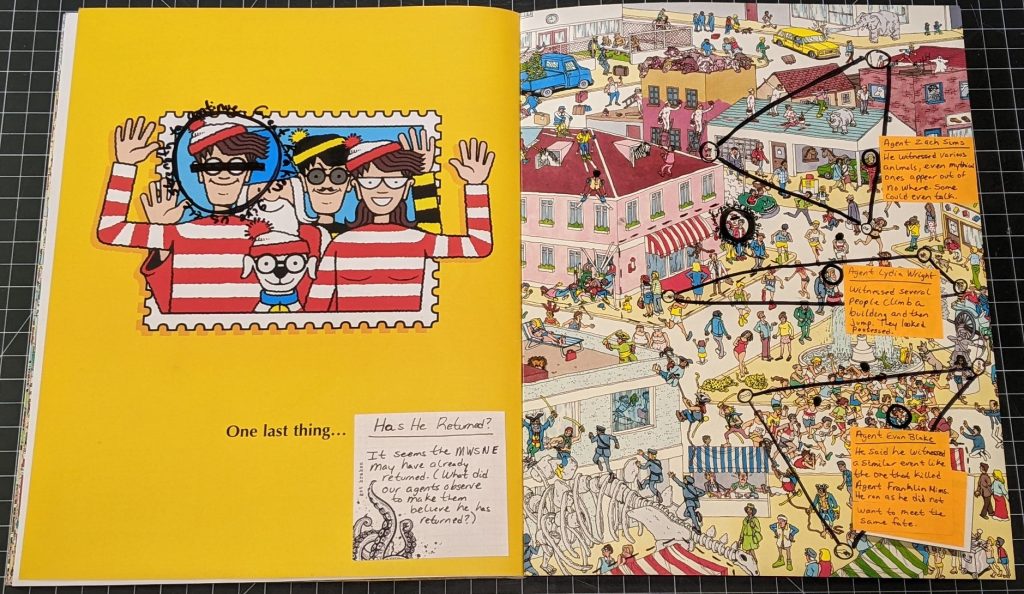Solo RPG
-
This Person Should Not Exist

This Person Should Not Exist is a solo artifact making game of surveillance weird horror by Speak the Sky. It can be found on itch.io. For this game you need a Where’s Waldo/Where’s Wally book from the main series that has 12 2-page spreads that contain all the nine “Entities of Power” which are people and objects you have to search for, sticky notes, a marker like a sharpie and a pen. A quick note, the book should be one published in 1997 or later, as earlier editions don’t have all the things you need to find.
You work as an analyst for a secret organization which deals with occult threats to humanity and are assigned the case of the Man Who Should Not Exist, who is a dangerous supernatural entity. Your job is to look at photographs and video stills from before a calamity happened which were caused by rituals the Man Who Should Not Exist did for an even greater being of power.
There are twelve cases and in each you find the Man Who Should Not be Named, circle him, cross out his eyes and write a different short prayer around the circle each time in the hope to stay safe. You then have to find the Entities of Power. For every three Entities of Power you locate, you draw lines between them to form a triangle. Once you find all the Entities of Power, you should have three triangles. In each triangle you will find a person of interest for the case you are currently working on and add a sticky note with a codename, answer that case’s question and include at least one Entity of Power from that triangle in the answer. The last thing is to find objects and people that the Man Who Should Not Exist has contaminated and mark them either by blotting out their face or drawing a rectangle around the objects to identify them as kill zones. Contamination can be identified by the red and white stripes that have spread throughout the area.
I really enjoyed this game. It was different from any other solo game I have played so far. I’ve actually never done a Where’s Waldo Book until this game. I used the first Where’s Waldo book. I used kraken post it notes from Muze Lab to write the case file notes. Since they had a kraken on them I decided my secret organization was called The Order of the Kraken and their prayers are always to the kraken god. I messed up while playing my game. I forgot to use codenames and I didn’t always include an entity of power when answering the questions.
My book had some spreads that had duplicate entities of power. I marked them with a question mark and wrote that maybe they were using it as a decoy or a duplicate to make sure their ritual succeeded. My book also had an extra scene on the inner back cover. It was part of the background from the first spread in the book and then people and characters from various spreads in the book. So I created my own question.
Case File #13: Has He Returned? It seems the MWSNE may have already returned. (What did our agents observe to make them believe he has returned?)I do think the game can be replayed a few times as long as a different Where’s Waldo/Where’s Wally book is used. Since the scenes would be different, you’d create different answers to the questions. I hope the creator will someday come out with an expansion with different cases and questions.
Below are a couple of spreads from my book. You can click on them to view a larger image.
-
Dwarf Mine: Barrier Mountains
Dwarf Mine: Barrier Mountains is a sci-fi expansion to Dwarf Mine, which is a solo map making adventure game created by James Hron of Paper Dice Games. I was given this expansion and the main game for free in exchange for an honest review.
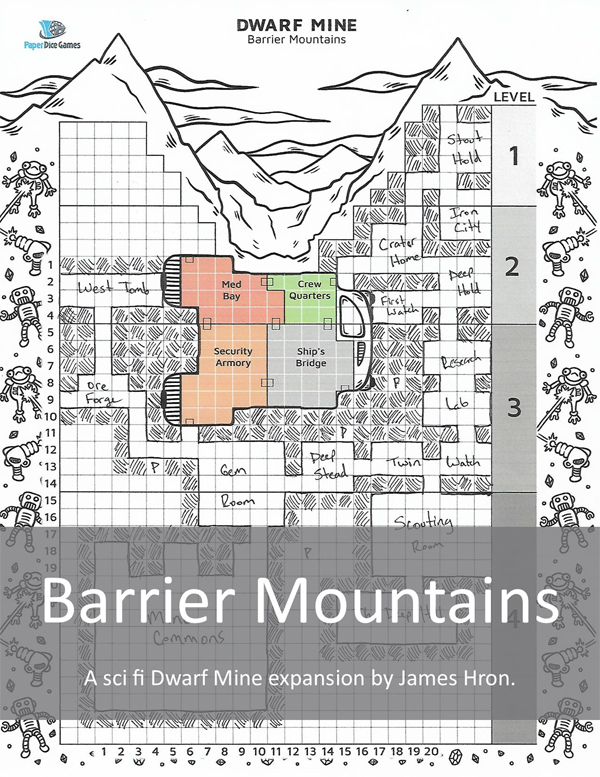
“The Barrier Mountains are the site of a strange falling star from years ago! Your mine will strike the earth at the Barrier Mountains, and uncover the secrets of an ancient artifact buried deep below. Will you discover its secrets? Or will your mine fall to the odd creatures that inhabit these mountains? Play to find out, as your mine tells its story!”
Barrier Mountains requires Dwarf Mine to play and includes a few new rules and rooms. Just like Dwarf Mine, the rules in this expansion are easy to learn. The core game play is the same as Dwarf Mine; play happens in three phases: your turn, treasure and combat, and persistent events. The game ends when all your dwarves are dead.
There is a new mountainscape and, in the center of the mountain, is a ship which includes 4 of the new rooms. The rooms are crew quarters, med bay, security armory, and the ship’s bridge. To access the rooms on the ship, you will need to build a hallway or ladder to the rooms’ doors and you will need keys in the colors of the rooms. Once you have the key for a room, either through research or being found, you will then have access to its benefit. The benefits include rolling for more gold per turn, increasing your laser attack, rolling to regain some population during combat, or rolling an additional die when using any of the ship’s room benefits. The research lab is the last new room. It allows you to research a key once per turn.
The new mountainscape has numbers along the x and y axes. These numbers are for when you use grid dice. You roll grid dice to determine where a plantoid will grow. Plantoids are an enemy that, when you encounter them, you roll a d20 for the x-axis and a d20 for the y-axis to see where it will grow in the mountain. If it grows in a room, you will lose that room’s benefit until the plantoid is destroyed. If they grow in an area not built on yet, you will not be able to build there until you destroy it. In order to destroy the plantoid, you must have or build a room, ladder, or hallway adjacent to it.
You also get a new attack die which fits into the sci-fi theme as well; the laser attack die. If you find a laser pistol, laser rifle, or gain access to the security room, you gain the laser attack die. During combat, you can then roll both the attack die and the laser attack die, adding the results of both to get the total damage you will inflict on your enemy. The laser attack die has its own dice chain. The dice chain is as follows: 0 – d8 – d10 – d12 – d20 – 2d10 – 2d12 – 2d20 – 3d20 – 4d20. You go up the dice chain as you find laser pistols, laser rifles and orange keys. The laser attack die is very useful, since quite a few of the enemies have a lot of health.
There are also ignition codes. If you find an ignition code and all of the ship’s rooms can be used, you may use the code to fire up the ship’s engines and ignore the result of one combat roll. Ignition codes can only be used once but you can find multiple ignition codes to use.
Besides the regular enemies like dire wolves and cave bears, there are also sci-fi themed enemies like metal men, aliens, plantoids, and plantoid vines.There are four Barrier Mountain bosses which you roll a d4 to determine which one you will face. There is a Frogling Supreme Commander who has a 4d20 attack. The Ship’s A.I. which does not attack but, if not defeated, you will lose access to all of the ship’s rooms and their benefits. A Seed that doesn’t attack but all plantoids will move towards it and, if they reach the room the Seed is in or are all killed the Seed, becomes a mega-plantoid. The last boss is a Xenolien which you can choose to fight or try to hide. If you hide, you roll the Xenolien’s attack die to see how many dwarves it targets. Then for each dwarf you roll a d6. On a 4 or higher the dwarf was able to hide and, on a 3 or less, they were found and eaten.
I enjoyed this expansion. I like the sci-fi theme and the new game mechanics. Especially the laser die and the ship’s benefits. You do have to be strategic when placing buildings since the ship is part of the mountain so there is less building space. Unlike the main game, the Barrier Mountains expansion does not have achievements. I think it would be nice to include some achievements specific to this expansion, like ones for each of the bosses, maybe one for having a lot of plantoids or destroying a lot of plantoids. For all of my playthroughs, I also used the Bloodlines and More Rooms expansions found in the main game.
In one of my playthroughs, I was able to finally beat my first Dwarf Mine boss, the Frogling Supreme Commander. In my next playthrough, I lost all the ship’s benefits because the A.I. survived and then my dwarves were decimated by the Frogling Supreme Commander. I’m looking forward to playing again and hoping my dwarves can go up against the Xenolien. For the mine where I killed my first boss, I lasted 15 years with 306 prestige. For my last playthrough, I lasted 22 years with 207 prestige.
Below is the brief history of the last mine I played:
Thinher Bolhak the Glorious had heard of the stories of the falling star at Barrier Mountains. He had always been curious about it and decided to build his mine, Xulboram there in the hopes of learning more about this fallen star. As they delved further in the mountain they discovered the fallen star was a ship and he immediately had his people build a research lab to find a way into the ship. Eventually they had access to the whole ship and reveled in its benefits. As they delved deeper they encountered plantoids, a synthetic plant like organism. They were able to destroy several. They also encountered metal men and frogling aliens. But then the ship came alive. They tried to defeat the A.I. but unfortunately were unable to and lost access to all the ships benefits. Before they could get over their defeat, they were attacked by the Frogling Supreme Commander and were slaughtered.
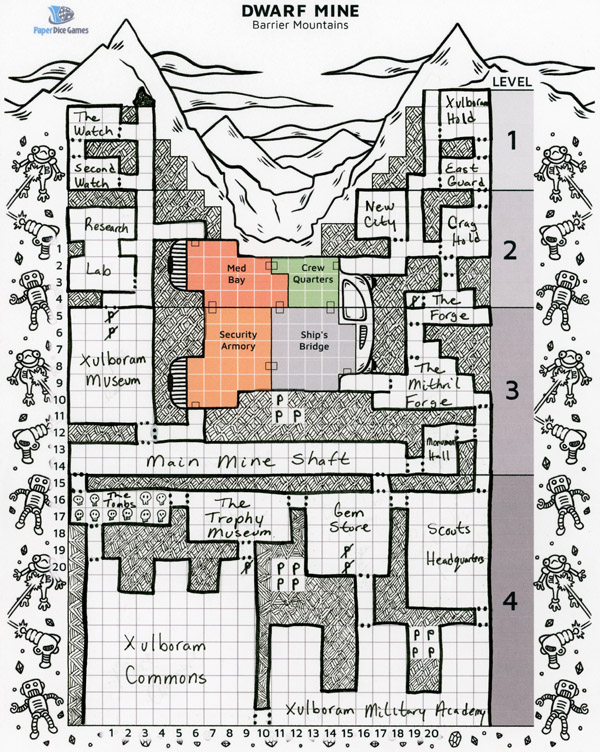
Map of Xulboram. -
Dwarf Mine
Dwarf Mine is a solo map making adventure game created by James Hron of Paper Dice Games. I was given the game and its expansion Barrier Mountains for free in exchange for an honest review. The review for Barrier Mountains will go up sometime next week.

“Dwarf Mine is a game about drawing and designing a mine, uncovering treasure, and surviving the dangers of the mountain.
In Dwarf Mine, you will draw your mine on graph paper, roll dice to determine what gold, gems, or other treasure you’ve discovered, and (hopefully) defeat monsters in combat, keeping your mine alive and thriving!
By the end of your game, you’ll have created a rich and unique history for your mine – no two games are the same!”
Besides the main rules, Dwarf Mine also comes with four mini expansions:
- “Mountain Creation” which allows you to customize the mountain by creating inaccessible caves and adding treasure to the last level.
- “More than a Dragon” gives you different enemies to fight at the end. Besides the dragon, you could fight the First of the Stone Folk, the Mother Root or a Goblin Invasion.
- “Bloodlines” helps you create your dwarf leader and gives you a random unique ability.
- “More Rooms” can help your mine quite a bit but can also make your mine a little challenging to design.
To play the game you need the mine sheet and Mountainscape grid, which can be found on the Paper Dice Games website, writing/drawing tool and several dice (d4, d6, d8, d10, d12 and d20) or a dice app.
The rules are easy to learn so you can start playing within minutes. The game is played in three phases; your turn, treasure and combat, and persistent events. During your turn you add a year to the age of your mine, build halls and ladders, build as many rooms as you can afford, and use the benefits of any rooms. Some rooms have one time use benefits and others have benefits you can use each turn. Rooms must be connected to a built section of your mine by a hall or a ladder.
In the treasure and combat phase, you can roll for treasure as long as you have built at least one hall, ladder or room. To determine your treasure you roll a d8 and add your mine’s age. You then look at the table for the mine level you are in to see what treasure you receive. Once that is done you roll for combat. The combat roll is made in the same way as the treasure roll; roll a d8 and add your mine’s age and then look at the table for the mine level you are in. You will then enter into combat. Combat is simultaneous; which means your mine attacks the enemy and the enemy attacks your mine at the same time. You roll your current attack die and add any modifiers to determine the damage dealt to your enemy. Then you roll the enemy’s attack die, plus any abilities they have, to determine the damage your mine receives. For any damage received, you lose an equal amount of population. You continue with simultaneous attacks until the enemy has no health (you win) or your mine’s population is zero (your mine is lost.)
In the persistent phase, certain enemies will continue to impact your mine until they are defeated or leave your mine. Persistent enemies only attack once in normal combat. There are specific rules for each persistent enemy that you follow during the persistent phase. You can attack them as many times as you want during this phase and, if you defeat them, you earn prestige equal to their original health. Your mine level increases by one if they leave or you kill them.
The game inevitably ends when your entire population is dead. Once this happens, you add up your prestige and mine age to use as a final score. Then you can compare it to previous games or to your friends’ games.
I had a lot of fun playing the game despite my mines and dwarves not surviving for many years. During my first couple of playthroughs, I just played the game without the expansions; that way I could get a hang of the base game. All the other playthroughs included some or all of the expansions. I liked how the mine could only be so many levels, which meant as you designed it, you had to try to plan well since eventually you would run out of space. Though I wouldn’t mind an expansion that allowed for a few more levels. I also liked the dice attack chain which went from a d4 to a d20. As you build barracks your attack die moves up the chain or, if you get a specific ability in the Bloodlines expansion, you can start higher in the chain. Some enemies can also have their attack die go up the dice chain as well.
I liked all the mini expansions, especially Bloodlines for the special ability it gave my dwarf leaders, and More Rooms for the benefits the extra rooms could give. I also appreciated the dwarf leader name table included in Bloodlines. I am terrible at naming things so this made it easy. There is also a room name table on Appendix 2 if you don’t want to always name your barracks “barracks” or hovels “hovel”.
Finally, there are also achievements that you can earn during multiple plays. Achievements give all your future dwarf leaders a title they can use. I like the idea of achievements, however I wish some of them had a benefit to using them. For example, if you completed the Kill the Dragon achievement, when you use the title Dragonslayer on one of your dwarf leaders, you’d get 10 more gold at the start of your mine creation or an advantage against any future dragons fought. I don’t think all of them should have a benefit but it would be nice with the bigger achievements.
I definitely plan to play this game more. I want to last more than 17 years and really would like to finally defeat an end game enemy. Dragons are mean and the First of the Stone Folk is even worse. If you’ve played Dwarf Mine, what was your best playthrough? If you haven’t, let me know if you beat my current best of 17 years with 133 prestige!
Below is the brief history of the last mine I played:
King of the Mountain, Gimhar Bulheft, built Karak Darum in the hopes of giving his people a prosperous place to live. He did not fear battle and his bravery gave his people strength and courage. The early years went smoothly. The mine prospered and, though they fought many enemies, they easily defeated them. But then things changed; their luck seemed to run out. Several stone folk broods dwindled their population and, on the final day of Karak Darum, they encountered the First of the Stone Folk. Having no room to imprison the enemy, they decided to bravely charge the First of the Stone Folk, knowing they would not survive.
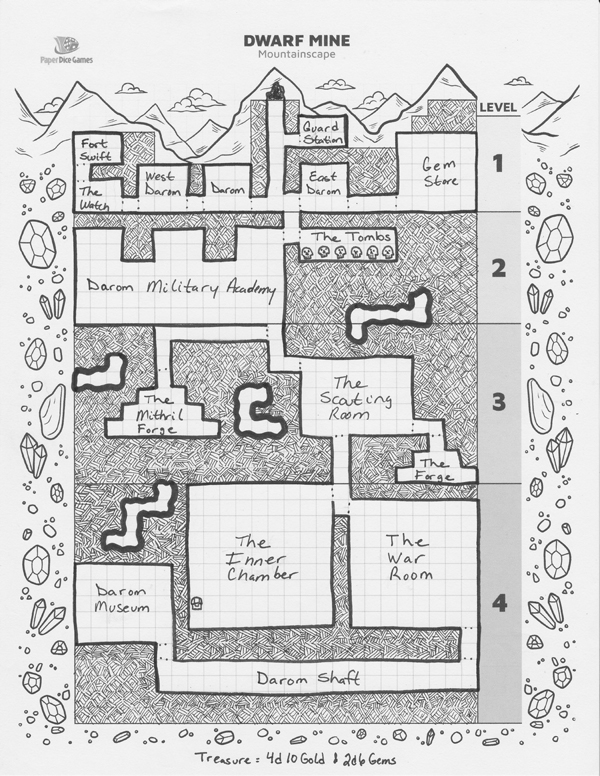
My map for Karak Darom.
Note: The Darom Military Academy is not drawn correctly. Its the right length but the smaller sections should be shorter in height. -
The Coming of the Dark Templars: An Adventure for Alone Against Fear
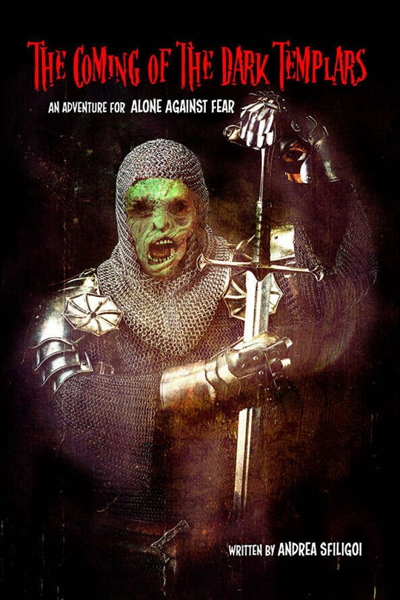
The Coming of the Dark Templars is an adventure for Alone Against Fear by Andrea Sfiligoi. In this adventure the Dark Templars, who were demon worshipping knights have come back to life due to the events that occurred in Alone Against Fear. They have come back to punish the descendants of those that tortured and killed them. This adventure comes with a map of the town where the dark templars are located. There are also new skills like lockpicking and medieval swords.
In this adventure you start at a random numbered location and move from numbered location to numbered location. Each time you stop at a location you read the entry for it and some locations have tables you have to roll on as well. You can also travel between towns. The first time you won’t have to roll to see if you encounter something but all other travels between the towns you will have to roll on a couple of tables in the core book.
Some of the knights are blind but possess supernatural senses that help them find their victims by sound and hear their heart beat. So if you decide to sneak by one you will first have to do a will roll. If successful your heart beat remains steady and you can then do a stealth roll. If unsuccessful then your heart beat will let the knight know you are there and you can’t perform a stealth roll. There are also knights that are immune to bullets and ranged weapons. In my game however I allowed ray guns. I understand why arrows, bolts and bullets might not work on the knights armor but I felt that an alien ray gun wouldn’t have a problem.
I enjoyed the adventure. However The Village of the Living Dolls is still my favorite. I wish there had been more info on the dark templars. One of the things I liked in The Village of the Living Dolls was that as you searched the town you found more info on the history of the town. In The Coming of the Dark Templars there really wasn’t much of that. Though it could be possible that there is some info but I just didn’t come across it during my play through. This adventure was also a lot shorter than both the core game and The Village of the Living Dolls.
My character, Sam encountered various knights, saved 2 citizens, learned how to lockpick, convinced a priest to bless the water tower though she never got to use it and then found out how to defeat the knights and was successful.
-
Twelve Years
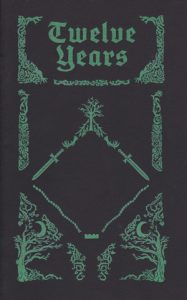
Twelve Years is a game by Max Moon Games. It is a solo+ rpg with no game master and can be played cooperatively, competitively or parallel. The premise of the game is that the Lich King at the Sunken Castle awakens and awaits his coronation. If he is not crowned, he and his minions will leave the castle to destroy the world. Players create a party of 4 adventurers who’s goal is to find the crown and crown the Lich King so he returns to his slumber. The journey might not be easy, as along the way they will have various encounters, some good and some not. They will also delve into dangerous dungeons in search of the crown and loot.
There is both hexploring and delving and everything is randomly generated with dice rolls. Time is tracked in years but only if your entire party dies or you are lost in the fae. When your entire party dies, a year passes and you create a whole new party that will set out to put the Lich King back to sleep. If 12 years pass then the Lich King leaves his castle and destroys the world.
There is combat in the game. The combat is more of a chaotic brawl then turn by turn encounter. Only a single dice is rolled to determine the party’s attack, defense, enemy’s attack and defense. The party attacks as one group but they will receive damage individually and the one receiving damage is chosen at random.
To play the game you only need the Twelve Years zine, 4-sided, 6-sided, 8-sided, 10-sided and 12-sided dice, a pen/pencil, paper, party sheet, hexploring sheet, delving sheet, and quick play sheet. The play, hexploring, delving and quick play sheets can be downloaded from the Max Moon Games website. I didn’t use the delving sheet as I used my own grid paper. I went all out with my hexploring sheet but that’s obviously not necessary.
I really enjoyed my first playthrough. I liked the story, the encounters and creating the maps. It was a fun few hours. My party seemed to do well on the way to the castle but things did get dire once there. One character died but thankfully I had a mushroom of rejuvenation which was able to resurrect her.
Below you can view the maps I created and read my party’s adventure as told by the storytelling bard, Menos.
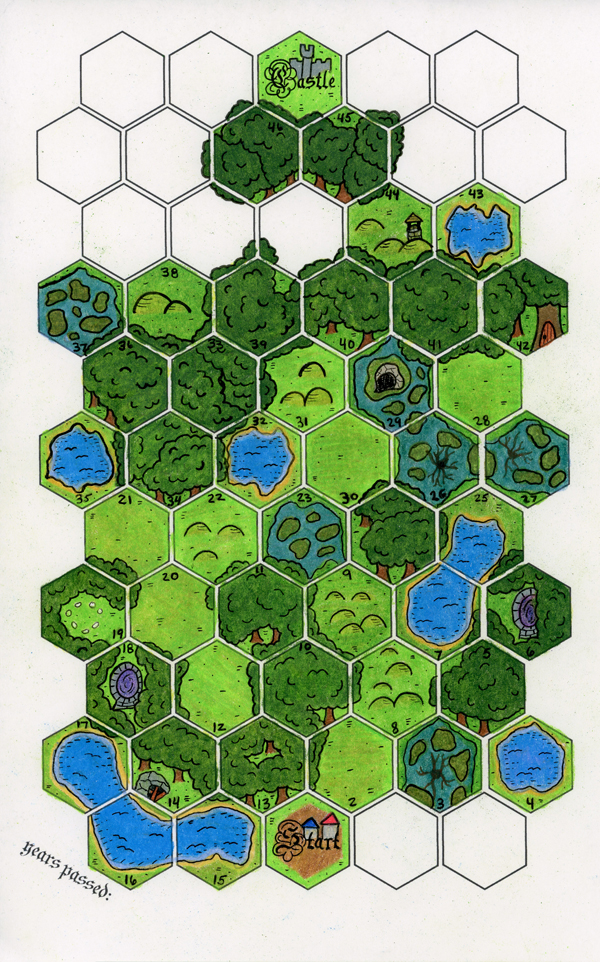
This is the map I created while hexploring. I used Prismacolor colored pencils and Faber Castel Pitt Pens.

Here are the maps I created for the two dungeons the party went in and the castle. I just used Faber Castel Pitt Pens.
Have you heard the tale of the last adventurers to head to the castle? No. Well let me tell you. It is said they all met at The Fire Dragon Inn. None of them knew each other and all were from various parts of the world and like so many others they were determined to stop the Lich King. Would they succeed? Nobody knew. These adventurers had no tales that followed them. They were unknowns. But unlike so many others they didn’t seem interested in fame or fortune. They genuinely just wanted to stop the Lich King because it was the right thing to do. We only knew their names because the giant Wanda was a talker. There was Claudia the hermit, Samantha the rogue and Victoriana the fae folk. They set out for the Sunken Castle without much fanfare and without many people even noticing. The stories say they fought many creatures like a treachery of ravens, poisonous toads, giant beetles, zombies and more. They emptied a couple of dungeons and they helped a few lost nobles and traveling merchants. They also gained members; another rogue by the name of Sarah and a fae folk named Lela. The famous dragonhunter, Gerhardus Zauber even said he met them and joined them for a bit before heading back to dragon hunting. They eventually found a crown while helping a walking, talking tree and some tree folk. With a crown in hand they headed for the castle. When they reached the castle it is said they thought they were ready but maybe they should have gotten a little more experience before heading in as it is believed one or two died but were brought back to life by magic. But in the end it all worked out and they were able to crown the Lich King and put him back to sleep. They returned to the inn to rest up and by morning they had all gone their separate ways. - Menos the Storytelling Bard

